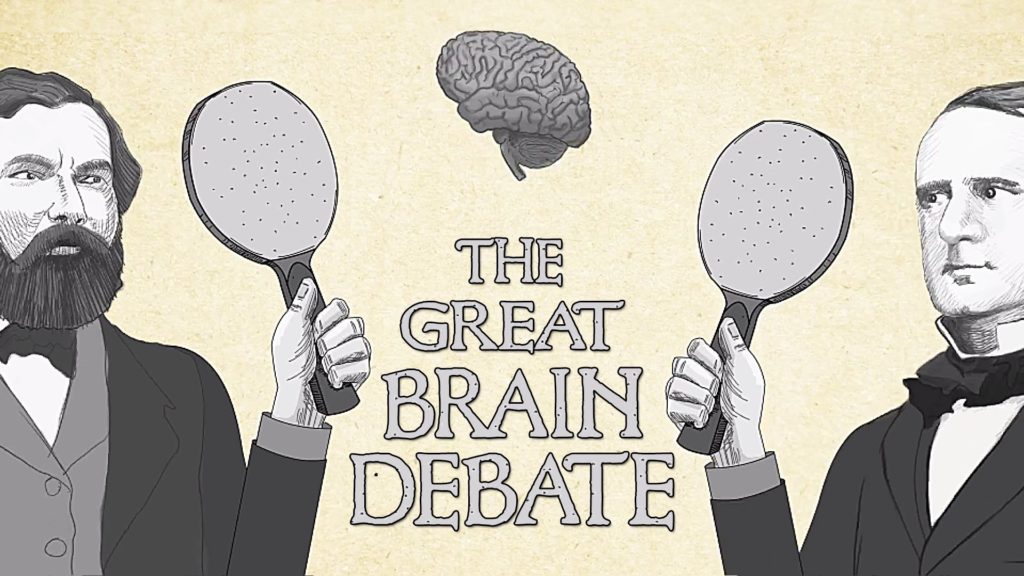The great brain debate

In 1861, two scientists got into a very brainy argument. Specifically, they had opposing ideas of how speech and memory operated within the human brain. Ernest Aubertin, with his localistic model, argued that a particular region or the brain was devoted to each separate process. Pierre Gratiolet, on the other hand, argued for the distributed model, where different regions work together to accomplish all of these various functions. The debate they began reverberated throughout the rest of the century, involving some of the greatest scientific minds of the time. Aubertin and his localistic model had some big names on his side.
n the 17th century, René Descartes had assigned the quality of free will and the human soul to the pineal gland. And in the late 18th century, a young student named Franz Joseph Gall had observed that the best memorizers in his class had the most prominent eyes and decided that this was due to higher development in the adjacent part of the brain. As a physician, Gall went on to establish the study of phrenology, which held that strong mental faculties corresponded to highly developed brain regions, observable as bumps in the skull.
The widespread popularity of phrenology throughout the early 19th century tipped the scales towards Aubertin’s localism. But the problem was that Gall had never bothered to scientifically test whether the individual brain maps he had constructed applied to all people. And in the 1840’s, Pierre Flourens challenged phrenology by selectively destroying parts of animal brains and observing which functions were lost.
Flourens found that damaging the cortex interfered with judgement or movement in general, but failed to identify any region associated with one specific function, concluding that the cortex carried out brain functions as an entire unit. Flourens had scored a victory for Gratiolet, but it was not to last. Gall’s former student, Jean-Baptiste Bouillaud, challenged Flourens’ conclusion, observing that patients with speech disorders all had damage to the frontal lobe.
And after Paul Broca’s 1861 autopsy of a patient who had lost the power to produce speech, but not the power to understand it, revealed highly localized frontal lobe damage, the distributed model seemed doomed. Localism took off. In the 1870’s, Karl Wernicke associated part of the left temporal lobe with speech comprehension. Soon after, Eduard Hitzig and Gustav Fritsch stimulated a dog’s cortex and discovered a frontal lobe region responsible for muscular movements.
Building on their work, David Ferrier mapped each piece of cortex associated with moving a part of the body. And in 1909, Korbinian Brodmann built his own cortex map with 52 separate areas. It appeared that the victory of Aubertin’s localistic model was sealed. But neurologist Karl Wernicke had come up with an interesting idea. He reasoned that since the regions for speech production and comprehension were not adjacent, then injuring the area connecting them might result in a special type of language loss, now known as receptive aphasia.
Wernicke’s connectionist model helped explain disorders that didn’t result from the dysfunction of just one area. Modern neuroscience tools reveal a brain more complex than Gratiolet, Aubertin, or even Wernicke imagined. Today, the hippocampus is associated with two distinct brain functions: creating memories and processing location in space. We also now measure two kinds of connectivity: anatomical connectivity between two adjoining regions of cortex working together, and functional connectivity between separated regions working together to accomplish one process.
A seemingly basic function like vision is actually composed of many smaller functions, with different parts of the cortex representing shape, color and location in space. When certain areas stop functioning, we may recognize an object, but not see it, or vice versa. There are even different kinds of memory for facts and for routines. And remembering something like your first bicycle involves a network of different regions each representing the concept of vehicles, the bicycle’s shape, the sound of the bell, and the emotions associated with that memory. In the end, both Gratiolet and Aubertin turned out to be right.
And we still use both of their models to understand how cognition happens. For example, we can now measure brain activity on such a fine time scale that we can see the individual localized processes that comprise a single act of remembering. But it is the integration of these different processes and regions that creates the coherent memory we experience. The supposedly competing theories prove to be two aspects of a more comprehensive model, which will in turn be revised and refined as our scientific techologies and methods for understanding the brain improve.






Responses